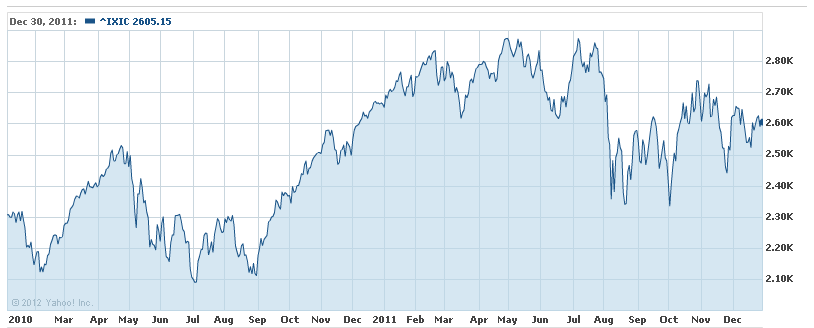Stock Market Trends 2011
Now at the beginning of 2012, it is a good time to look back at the stock market trends of 2011. This will not be the final account. The real review of the long-term stock market trends of 2011 can only take place in 6 months.
How we shall interpret the movements of the last few months will then only be clear. But here is what we can say now already.
US Market Trends
For the US markets, the first 3 months of the year continued the trend up that started in the beginning of 2009.Then we got 5 months of falling stock markets. The last 4 months, the markets have shown huge fluctuations. But the year ended roughly at the same level as September started. As it looks like at this moment, Q2 2011 was the beginning of a long-term down trend.
The US markets ended 2011 about at the same level as they started the year. The S&P 500 was exactly flat. The Dow Jones gained 5.5%, the NASDAQ lost 2% and the NYSE lost 6%. These differences show that the 30 stocks of the Dow Jones are not such a good indicator for the overall US market.
NASDAQ 2010 and 2011 Market Trends
European Stock Markets
The main European markets shown a very similar pattern as the US market. Also here the long-term trend seemed to have changed direction during Q2 2011. The difference between the US and European markets is that the losses in Europe for 2011 have been much bigger. The German DAX lost for example 15%, the French CAC about 17%. The UK FTSE kept the losses limited to 5.5%.
BRIC and Other Stock Market Trends
The biggest losses during 2011 were seen in the BRIC countries Brazil, India and China.
For these countries, the long-term stock market trend turned already down in Q1 2011. These emerging markets seem to run about 3 months ahead on the US and European markets. The 2011 losses were 18% for Brazil, 22% for China and 25% for India.
The Korean KOSPI seems to have followed the trends of the US and European markets.
The Hong Kong Hang Seng Index gives the impression to be merger of the Chinese market on one hand and the US and European markets on the other hand; about flat in the first half of the year and heavy losses in the second half.
The trends in the Australian S&P/ASX 200 show how much the Australian economy depends on China. The Australian and China markets seem to move in general nicely in sync.
Gold in 2011
Gold increased 9% in value over the course of 2011. The long-term trend for the Gold price points already up since the beginning of 2001. The last 6 month of 2011 showed very large fluctuations for the Gold price. At the end of August, Gold had an all-time month-end closing price. It closed the year 15% below that peak. In 6 months, we can see for sure if the current movements form just some temporary corrections or the beginning of the change in the long-term direction of the Gold Price.
Currencies
For the currencies, we can see that the Japanese Yen continued in 2011 its advance compared to the US Dollar that started in Q3 2007. From Q3 2010 onward, the Euro was strengthening versus the US Dollar. During Q2 2011, this trend turned direction. During the second half of 2011, the Euro is on a down trend versus both the US Dollar and Japanese Yen.
At the end of the year it is easy to see what the market trends were in 2011. However, now it is rather late to capitalize on the changes in long-term trend directions. Read here more about how you can get an early warning when the stock market trends are changing direction.
Next & Previous Blog Post
- ‹ previous
- 126 of 174
- next ›




